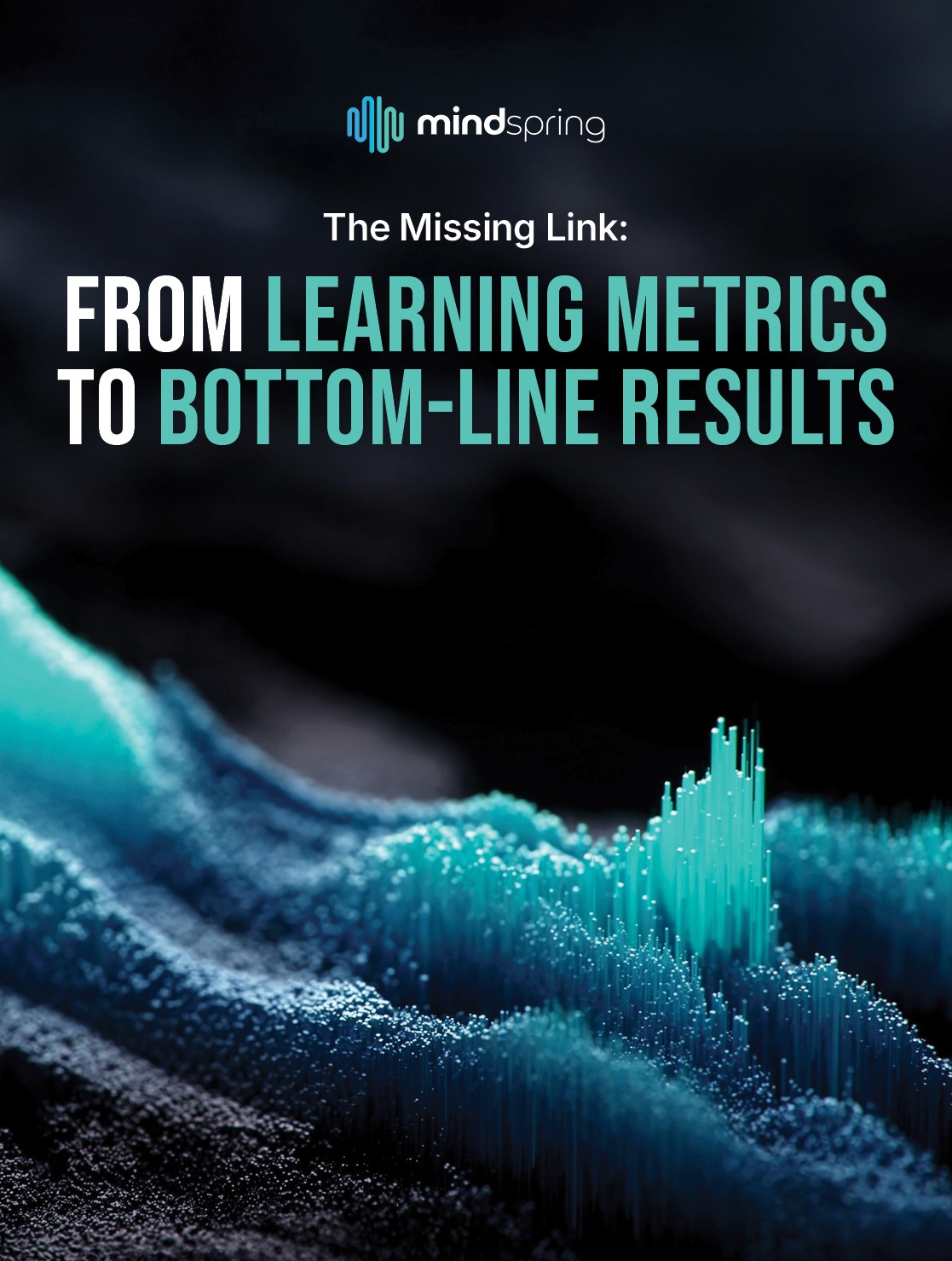
Understanding The Learning-To-Business Metrics Bridge
Defining The Two Worlds Of Measurement
To understand why most L&D teams struggle with ROI, we need to clearly distinguish between two fundamentally different types of metrics that often get confused or conflated.
Learning Metrics measure the effectiveness of the learning process itself. They answer questions like: Did people attend? Did they understand the content? Were they satisfied with the experience? Did they retain the knowledge? These metrics are internally focused, measuring what happens within the learning environment.
Business Metrics measure organizational performance and outcomes. They answer questions like: Are we selling more? Are we reducing costs? Are we improving quality? Are we retaining talent? These metrics are externally focused, measuring what happens in the real world of work.
The confusion between these two types of metrics has created a measurement crisis in L&D. Teams diligently track learning metrics, assuming they’re measuring business impact, while business leaders look for concrete evidence of value that never materializes.
Consider these common examples of the disconnect:
- Learning Metric: 98% of sales representatives completed the new product training program.
- Business Reality: Sales of the new product remain below target three months post-launch.
- Learning Metric: Customer service training received an average satisfaction rating of 4.7 out of 5.
- Business Reality: Customer complaint resolution times have increased by 15%.
- Learning Metric: Leadership development participants showed a 25% improvement in post-training assessments.
- Business Reality: Employee engagement scores in participating departments remained unchanged.

eBook Release
The Missing Link: From Learning Metrics To Bottom-Line Results
Explore proven frameworks for connecting learning to business outcomes and examine real-world case studies of successful ROI measurement.
The Expensive Illusion: Why Learning Metrics Aren’t Enough
While learning metrics serve important purposes—they help improve instructional design, ensure content quality, and track participation—they create a dangerous illusion when used as proxies for business value. This illusion carries significant hidden costs that many organizations fail to recognize.
Wasted Strategic Opportunity
When L&D teams focus exclusively on learning metrics, they lose sight of strategic business priorities. Without clear connections to business outcomes, training programs often target the wrong people with the wrong content at the wrong time.
A manufacturing company discovered this disconnect when it analyzed its extensive safety training program. Learning metrics showed impressive results: 100% completion rates, high knowledge retention scores, and excellent participant feedback. However, workplace incidents continued at the same rate. The problem wasn’t the quality of the training—employees were learning the safety protocols effectively. The issue was that without business-focused data collection, the company never identified that 70% of incidents occurred during shift changes when communication breakdowns led to safety oversights. Training could have addressed these communication gaps, but the L&D team was measuring satisfaction scores instead of incident patterns and root causes.
This misalignment represents more than inefficiency; it’s a strategic failure. Resources invested in well-intentioned but misdirected training could have been deployed to address actual business challenges. The opportunity cost extends beyond the training budget to include the ongoing business problems that remain unsolved.
Loss Of Credibility
Perhaps no scenario damages L&D’s reputation more than presenting positive learning metrics while the business struggles with performance issues that training was supposed to address. This disconnect makes the entire function appear out of touch with business realities.
Consider the L&D team that proudly reported 95% completion rates and 4.8/5 satisfaction scores for their customer service training program during the same quarter that customer satisfaction plummeted and competitor switching reached a five-year high. While the team celebrated their “successful” training program, business leaders questioned the relevance and value of the entire L&D function.
This credibility gap has long-term consequences. When L&D consistently reports metrics that don’t align with business performance, leaders begin to view the function as disconnected from real organizational needs. The result is reduced influence in strategic planning, limited access to decision-makers, and relegation to tactical execution rather than strategic partnership.
Budgetary Risk
The most immediate and tangible cost of metric misalignment is budgetary vulnerability. In economic downturns or periods of cost optimization, functions that cannot demonstrate clear business value face the highest risk of budget cuts or elimination.
This risk is particularly acute for L&D because training is often viewed as discretionary spending rather than essential investment. When organizations need to reduce costs quickly, programs measured only by learning metrics appear expendable compared to functions that can demonstrate direct revenue impact or cost savings.
However, this vulnerability can be transformed into protection through effective measurement strategy. L&D teams that can demonstrate concrete business impact—for example, reduced turnover saving $2.3 million annually, safety training preventing 40% of incidents, or sales training generating $5.2 million in additional revenue—become untouchable during budget discussions. Their programs are viewed as investments rather than expenses.
The Architecture Of Measurement Maturity
Organizations don’t leap directly from learning metrics to business impact measurement. Instead, they progress through identifiable stages of measurement maturity, each with its own characteristics and challenges.
Stage 1: Activity Tracking
At this foundational stage, organizations focus on basic participation metrics:
- Number of courses delivered
- Hours of training provided
- Participants trained
- Training events completed
These metrics answer the question “Are we busy?” but provide no insight into effectiveness or value.
Stage 2: Learning Effectiveness
Organizations at this stage measure whether learning is occurring:
- Completion rates
- Assessment scores
- Satisfaction ratings
- Knowledge retention metrics
These metrics answer “Are people learning?” but don’t connect learning to performance.
Stage 3: Behavior Change
More sophisticated organizations begin measuring whether learning translates to workplace behavior:
- Skill application rates
- Performance observations
- Behavior change assessments
- 360-degree feedback improvements
These metrics answer “Are people applying what they learned?” but don’t quantify business impact.
Stage 4: Business Impact
The most mature organizations connect learning directly to business outcomes:
- Revenue increases
- Cost reductions
- Quality improvements
- Safety incident decreases
- Retention improvements
These metrics answer “Did learning create business value?”
Most organizations get stuck between stages 2 and 3, collecting impressive learning metrics while struggling to demonstrate workplace application and business impact. The bridge between these stages requires intentional design and systematic measurement approaches.
Real-World Consequence: The Retail Chain Reality Check
A national retail chain’s experience illustrates the real-world consequences of metric misalignment and the transformation possible through proper measurement.
For three years, the chain’s L&D team reported consistently positive metrics for their customer service training program:
- 97% completion rate across all locations
- Average satisfaction score of 4.6/5
- 89% pass rate on knowledge assessments
- 92% of participants rated the training “highly relevant”
Despite these impressive learning metrics, the business struggled with declining customer satisfaction scores, increasing complaint volumes, and growing competitive pressure from retailers known for superior service.
The disconnect became impossible to ignore when a major competitor opened locations in their key markets and immediately captured 15% market share, primarily by delivering the superior customer experience that the chain’s training was supposed to create.
The turning point came when the L&D team shifted its measurement approach. Instead of focusing solely on learning metrics, they began tracking business outcomes:
- Customer satisfaction scores by location
- Mystery shopper ratings
- Complaint resolution times
- Customer retention rates
- Revenue per customer interaction
This business-focused measurement revealed that while employees were learning customer service concepts, they weren’t consistently applying them due to operational barriers, inadequate management support, and misaligned incentive systems.
The revised training program addressed these systemic issues while maintaining learning quality. Six months later, the results were dramatic:
- Customer satisfaction scores increased by 23%
- Mystery shopper ratings improved by 31%
- Complaint resolution times decreased by 40%
- Revenue per customer interaction grew by 18%
More importantly, the L&D team could now demonstrate concrete business value: the improved customer experience directly contributed to $12.4 million in retained revenue and $3.8 million in new customer acquisition.
Building The Bridge: From Learning To Business Impact
The transformation from learning-focused to business-focused measurement requires more than good intentions—it demands systematic approaches and organizational commitment.
Stakeholder Alignment: Successful measurement bridges begin with clear agreement between L&D and business leaders about what success looks like. This means identifying specific business metrics that training programs should influence and establishing baseline measurements before training begins.
Causal Chain Mapping: Effective measurement requires understanding and documenting the logical connection between learning outcomes and business results. If sales training is supposed to increase revenue, what are the intermediate steps? Improved product knowledge leading to better customer conversations leading to higher conversion rates leading to increased sales.
Multi-Level Data Collection: Bridging learning and business metrics requires collecting data at multiple organizational levels—individual performance, team outcomes, departmental results, and organizational impact. This comprehensive approach provides the evidence needed to demonstrate causal relationships.
Timeline Management: Business impact often takes time to materialize. Effective measurement strategies account for these delays, tracking leading indicators while waiting for lagging measures to reflect training impact.
The Strategic Imperative
The choice between learning metrics and business impact measurement is ultimately a choice between tactical activity and strategic value creation. Organizations that master the bridge between these two worlds of measurement don’t just improve their training programs—they transform their entire approach to human capital development.
The bridge from learning metrics to business results isn’t just a measurement challenge; it’s a strategic opportunity to demonstrate L&D’s true value to organizational success. In our eBook, The Missing Link: From Learning Metrics To Bottom-Line Results, we explore proven frameworks for connecting learning to business outcomes, examine real-world case studies of successful ROI measurement, and provide practical tools for building your own measurement system.
Source link




